Homemade Baklava
A classic recipe for Baklava, the traditional Greek and Turkish pastry made with ground nuts and buttery layers of phyllo dough, drizzled with a spiced honey syrup. Learn how to make this crispy Greek Baklava for holiday platters or special occasions!
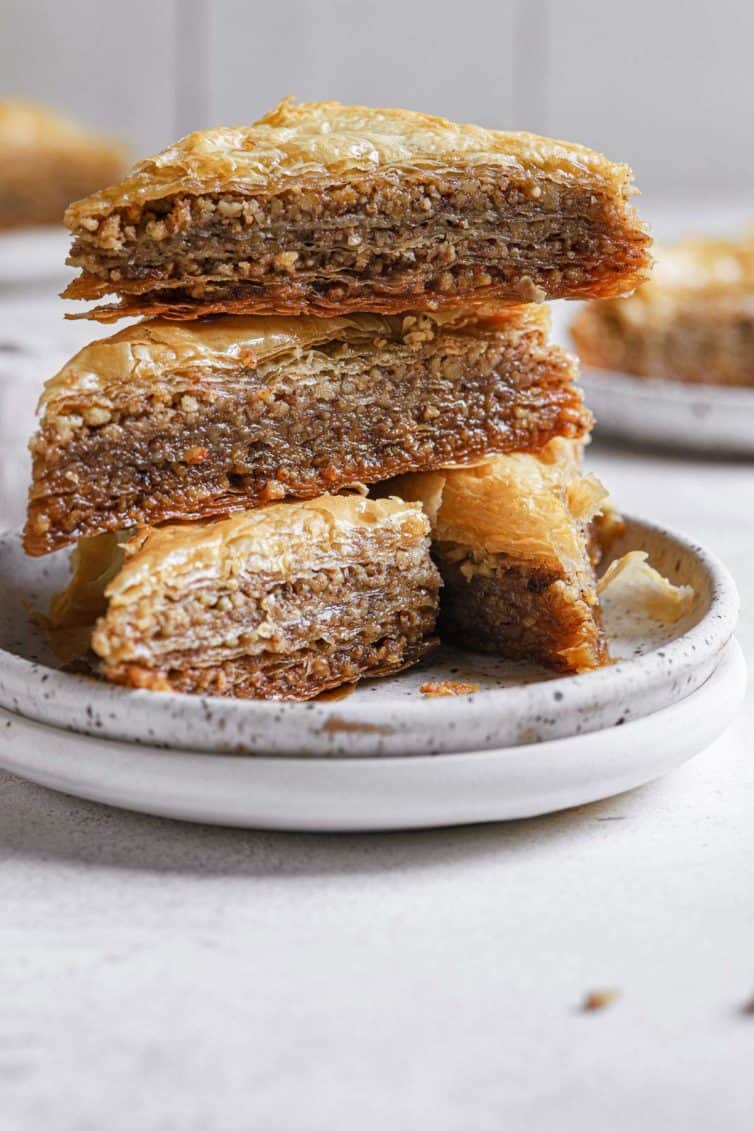
Long, long ago when my husband and I were dating and he was still living in the DC suburbs, we happened upon a summer Brewfest. After getting our tasting glasses and sampling brews such as watermelon beer, we hit the food tents. On our way out, we walked past a little Greek food tent manned by an older couple. They were charming and the pastries looked unbelievable; we loaded up on some baklava and headed home.
Later that night, we dug in and I suddenly remembered how absolutely phenomenal baklava is. Layers of buttery, flaky phyllo dough are piled high between sections of spiced, ground walnuts. Once baked and golden brown, the entire pan is drowned in a spiced honey syrup, which is left to soak in for hours. It’s sweet, a little sticky, a little spicy, and fabulously nutty.
I immediately emailed a friend who had deep Greek roots and asked if she had a recipe. She gifted me with her grandma’s recipe, and I made it a few months later for Thanksgiving. It was a rousing success, and it’s the only recipe I’ve used since.
The Origin of Baklava
Many people wonder if baklava is, indeed, a Greek dessert or if it is Middle Eastern in origin, so I did some research…
The first mention of a dessert resembling baklava goes way, wayyyyyy back to the BC age, which is incredible. The Greeks and the Turks still argue as to where the recipe originated, but the oldest version of this recipe (a baked dessert with layers of dough and covered in honey) shows up in the Roman Empire, and Greek and Turkish cuisine both built upon cooking traditions from the Byzantine and, later, Roman Empires.
When I do recipe research, it rarely, if ever, goes back THAT far. Amazing!
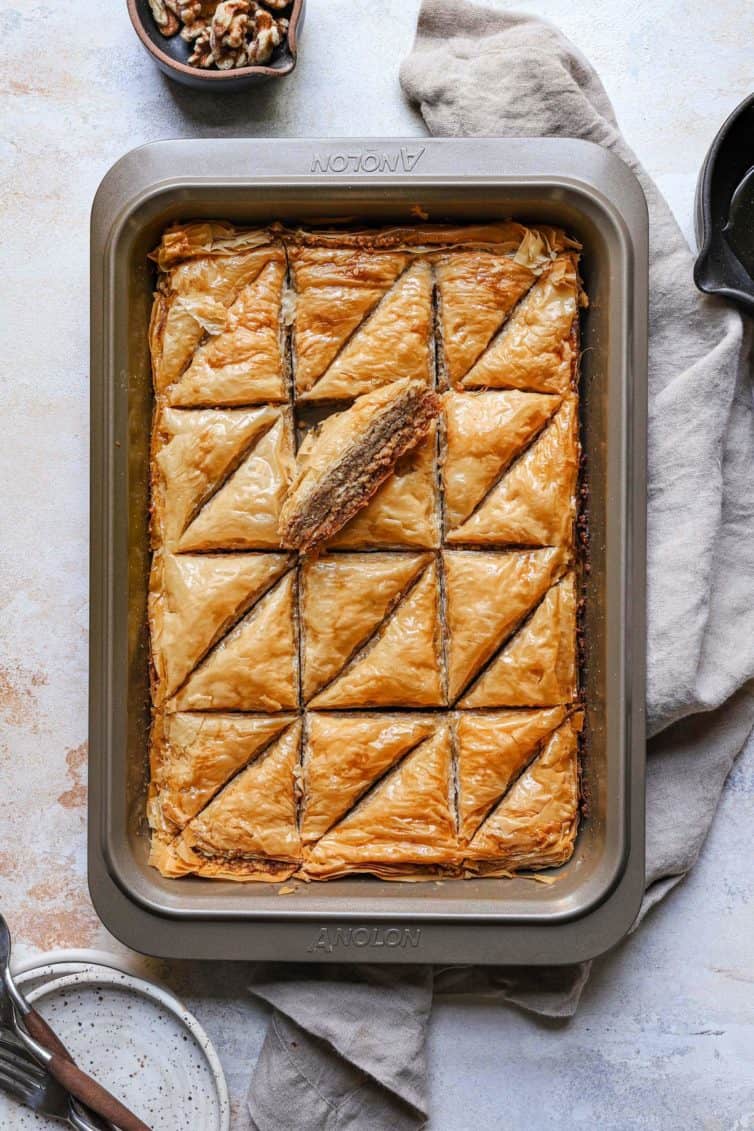
Regional Differences
Much like tres leches recipes have regional differences across the globe, baklava has similar roots in various countries. Each recipe still consists of flaky layers of phyllo dough and a chopped nut filling but you might notice a few differences. For example:
- Greece: Commonly uses walnuts and cinnamon in the filling.
- Turkey: Made with a filling of almonds, walnuts, or pistachios and topped with kaymak (similar to clotted cream).
- Iran: Cuts the baklava into diamond shapes and soaks in a rose water syrup.
- Lebanon: Made with a walnut filling but topped with orange blossom water and uses much less syrup for soaking.
This recipe leans more to the traditional Greek Baklava recipe made with walnuts, cinnamon, and a sweet honey syrup.
Recipe Ingredients
While many people find making baklava difficult, it’s a relatively easy recipe made with just a few simple ingredients.
The Syrup
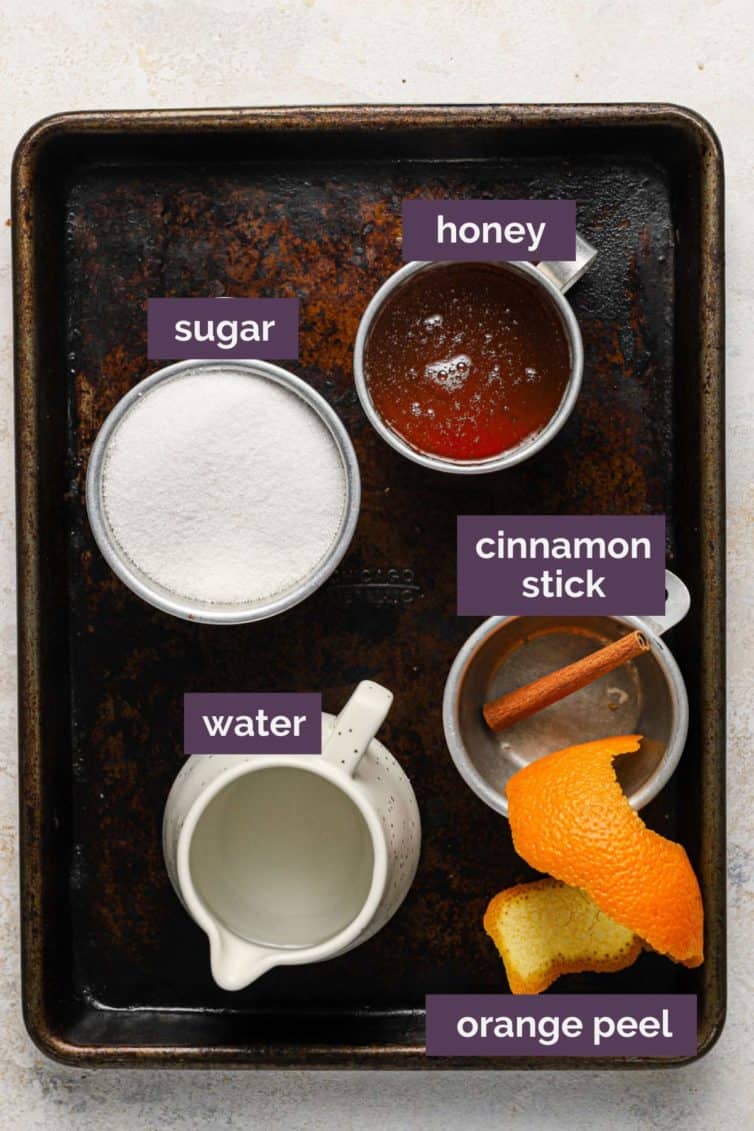
- Soaking syrup: Made from a mixture of water, sugar, honey, cinnamon, and an orange peel.
The Layers
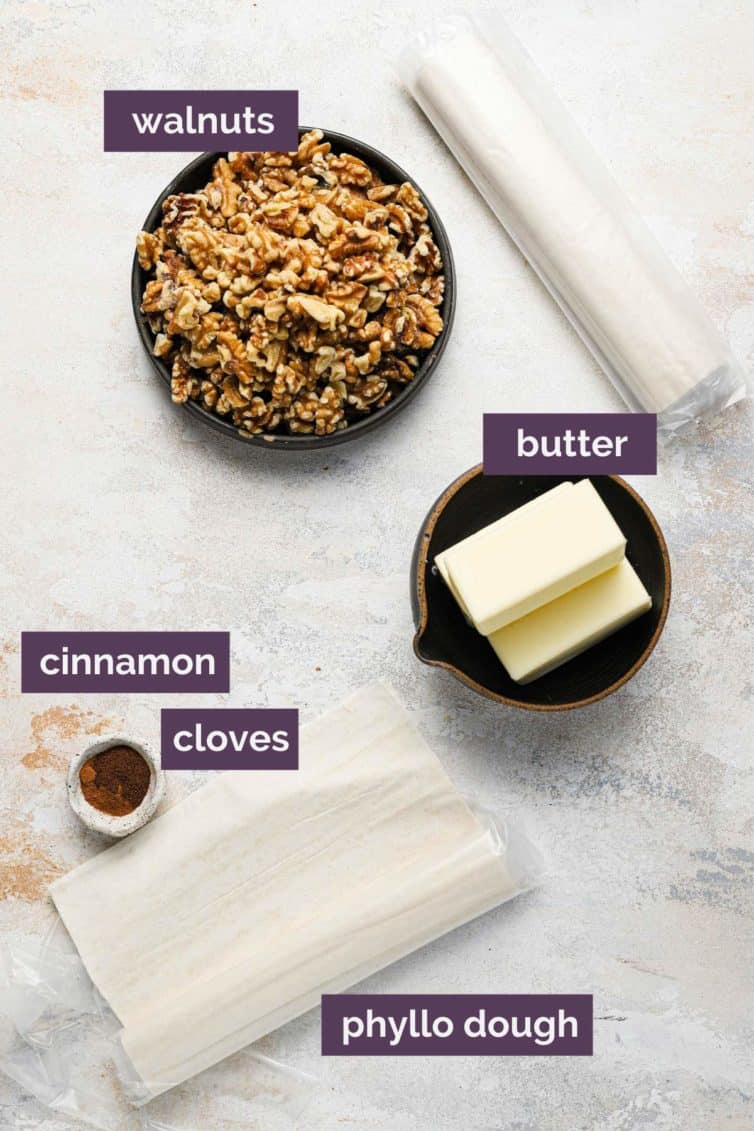
- Walnuts: Chopped walnuts are the main part of the baklava filling. You can also use pistachios or almonds or a mix of all of the above.
- Spices: A blend of cinnamon and ground clove season the chopped walnut filling.
- Phyllo (Fillo) Dough: These sheets make the flaky layers that hold the spiced walnut filling. See below for specific tips on working with it successfully.
- Unsalted Butter: Adds moisture to the baklava and aids in the flaking of the phyllo dough during the baking process.
Phyllo Dough Tips
I think the trickiest part of making baklava comes down to the phyllo dough. Here are a few tips and tricks to have the most success using phyllo dough in this recipe.
- Defrost the phyllo dough. The night before you plan to make baklava move the phyllo dough from the freezer to the refrigerator. If you try to use frozen dough it will crack.
- Cover the sheets of phyllo with a damp kitchen towel while you’re working so that they don’t dry out (they are very delicate to work with!).
- Keep the phyllo dough covered. After removing a sheet of phyllo dough replace to damp kitchen towel over the remaining sheets.
- Don’t stress if it rips. This dough is SUPER thin and prone to ripping. It’s okay if it rips, since you are piling layers on top it shouldn’t impact the baking and may give your baklava a rustic look.
How to Make It, Step-by-Step
The process to make baklava is fairly simple, albeit time-consuming. The layering and buttering of the phyllo dough will take some time so remember to be patient, the final product is well worth it. This baklava recipe comes down to a few simple steps:
- Make the Syrup
- Mix up the Filling
- Assemble the Baklava
- Bake + Soak with Syrup
1. Make the Syrup
- Mix ingredients: Combine water, sugar, honey, cinnamon stick, and an orange peel in a small saucepan.
- Bring to a boil, then simmer for about 15 minutes.
- Cool syrup before using: Set aside to cool completely while you make the filling and assemble the baklava.
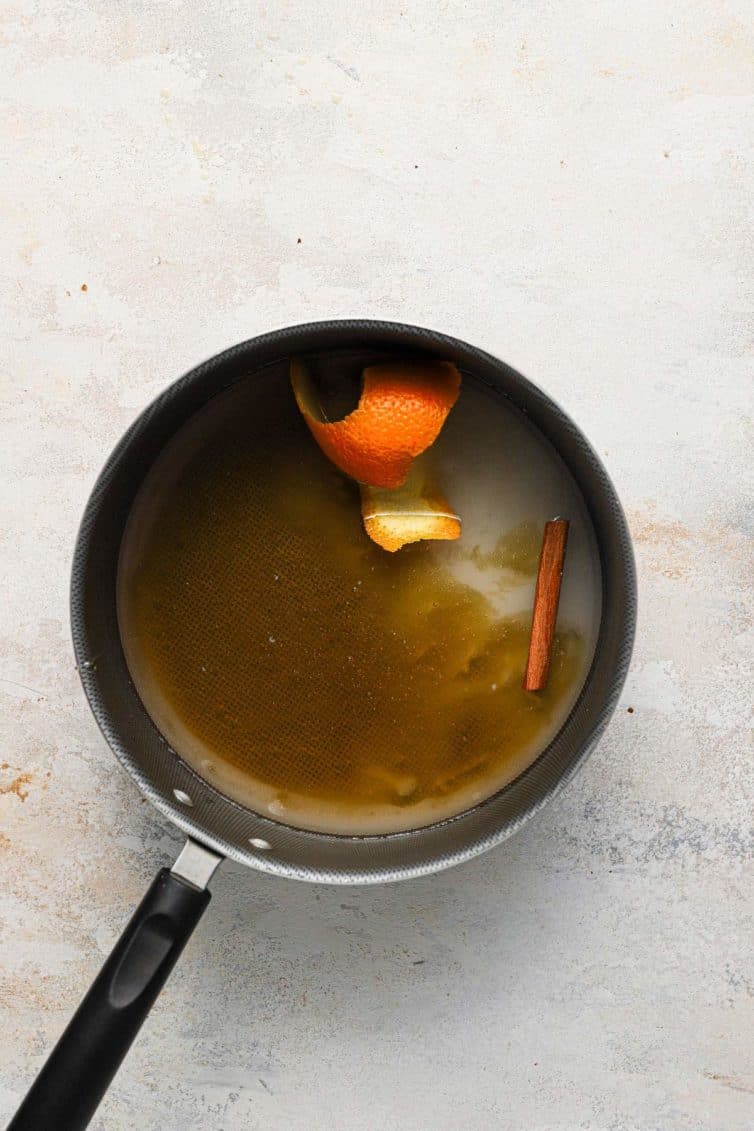
2. Make the Filling and Assemble
- Preheat oven to 350°F.
- Make the filling: Place walnuts, cinnamon, and cloves in a food processor and process until the walnuts are a medium-fine ground consistency. Too fine and you’ll end up with nut roll filling, but too coarse and the layers won’t adhere properly.
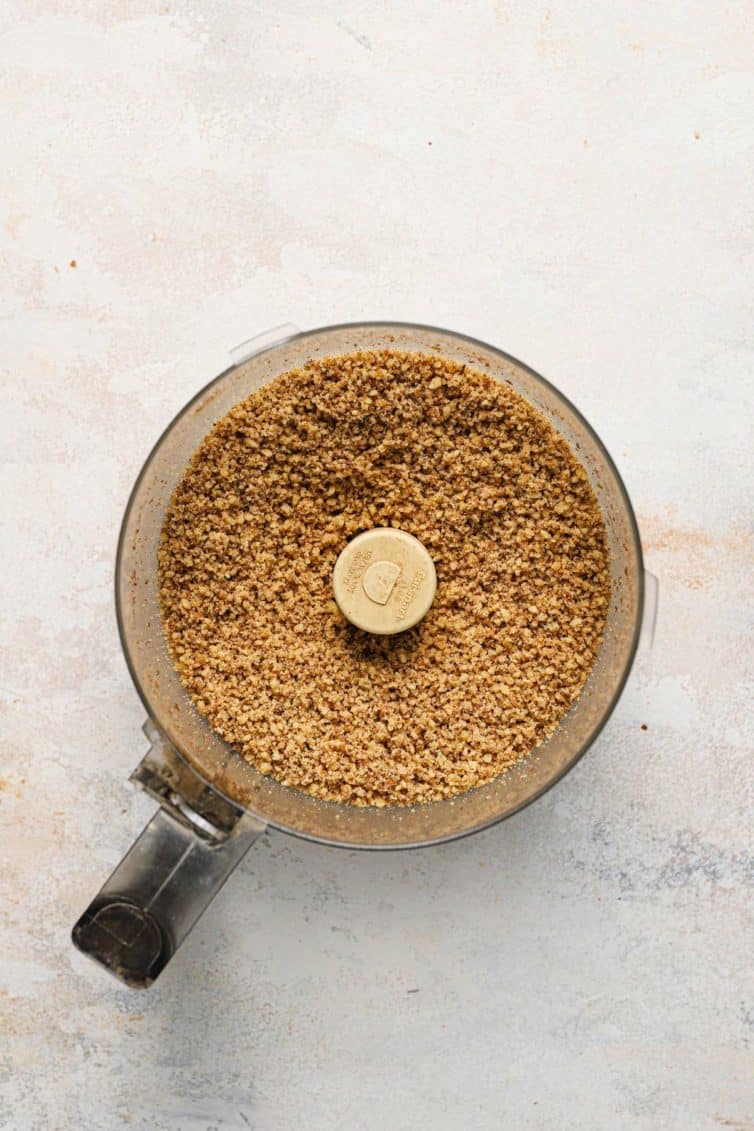
- Melt butter: In a small saucepan over low heat, melt the butter and keep it warm throughout the process so it doesn’t solidify.
- Assemble the base layer: Brush a 9 X 13-inch pan with melted butter and place one layer of phyllo at the bottom. Brush the phyllo with melted butter then add another layer of phyllo, and brush with more butter. Continue this process until you have layered 7 sheets of phyllo.
- Spread the nuts: Gently spread one-quarter of the nut mixture evenly over the top of the phyllo.

- Add next phyllo dough layer: Repeat the process of layering phyllo sheets and brushing with melted butter, this time only use 5 sheets of phyllo.
- Second layer of nuts: Spread another quarter of the nut mixture over the top of the phyllo.
- Repeat twice more, layering and buttering 5 sheets of phyllo and topping with one-quarter of the nut mixture.
- Top with last layers: Finish with 7 layers of phyllo and brush the top sheet with melted butter as well.
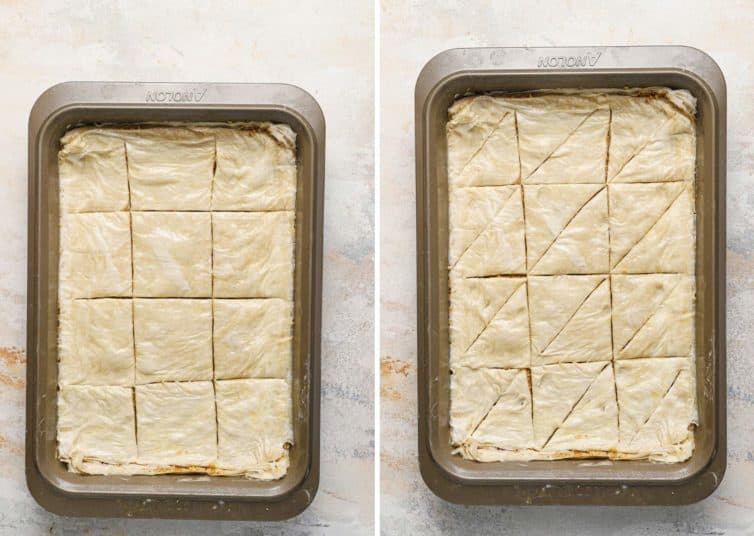
- Cut the baklava: Using a sharp knife, trim any ragged pieces of phyllo dough that has crept up the sides of the pan. Cut the baklava into 12 even squares, and then cut into triangles. You should have 24 triangles.
3. Bake and Soak with Syrup
- Bake baklava: Place the pan in the oven and bake until golden brown, about 50 minutes.
- Soak with syrup: As soon as the baklava comes out of the oven, grab the honey syrup and pour it all over the top, making sure to get it into all of those crevices, as well. You’ll hear lots of crackling, which is a glorious sound! Then… you wait. At least four hours, but ideally overnight.
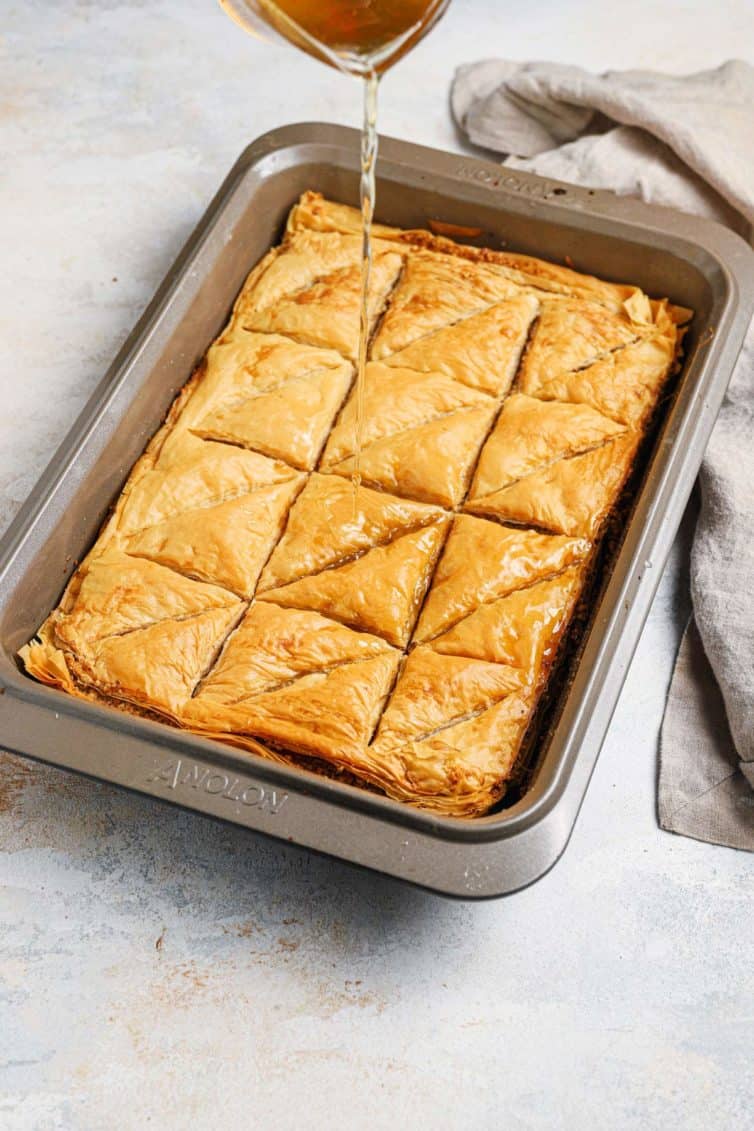
Troubleshooting Baklava
While the process is pretty straightforward, let’s address some of the questions or issues you might have while making it:
This is likely due to using too much butter when brushing the phyllo sheets. A thin coating of butter is all that’s needed.
Be sure that when you brush your layers of phyllo, and especially the top layer, that you are brushing all the way around the ends and in the corners. You don’t want to leave any areas of phyllo exposed, or they will dry out.
I have seen recipes online that substitute things like sesame seeds, coconut, dried apricots and raisins, etc. for the nuts in baklava. I’ve never tried any of them so I can’t attest to how close they are to the real thing, but they do exist!
Well, honey does impart a lot of the characteristic flavor of baklava, but you can do without it. A simple sugar syrup can be poured over, or you can flavor it with things like rose water. You could also use agave nectar.
Store the baklava without tightly wrapping it up in plastic. When stored at room temperature with a loose tea towel it prevents the phyllo dough from getting soggy.
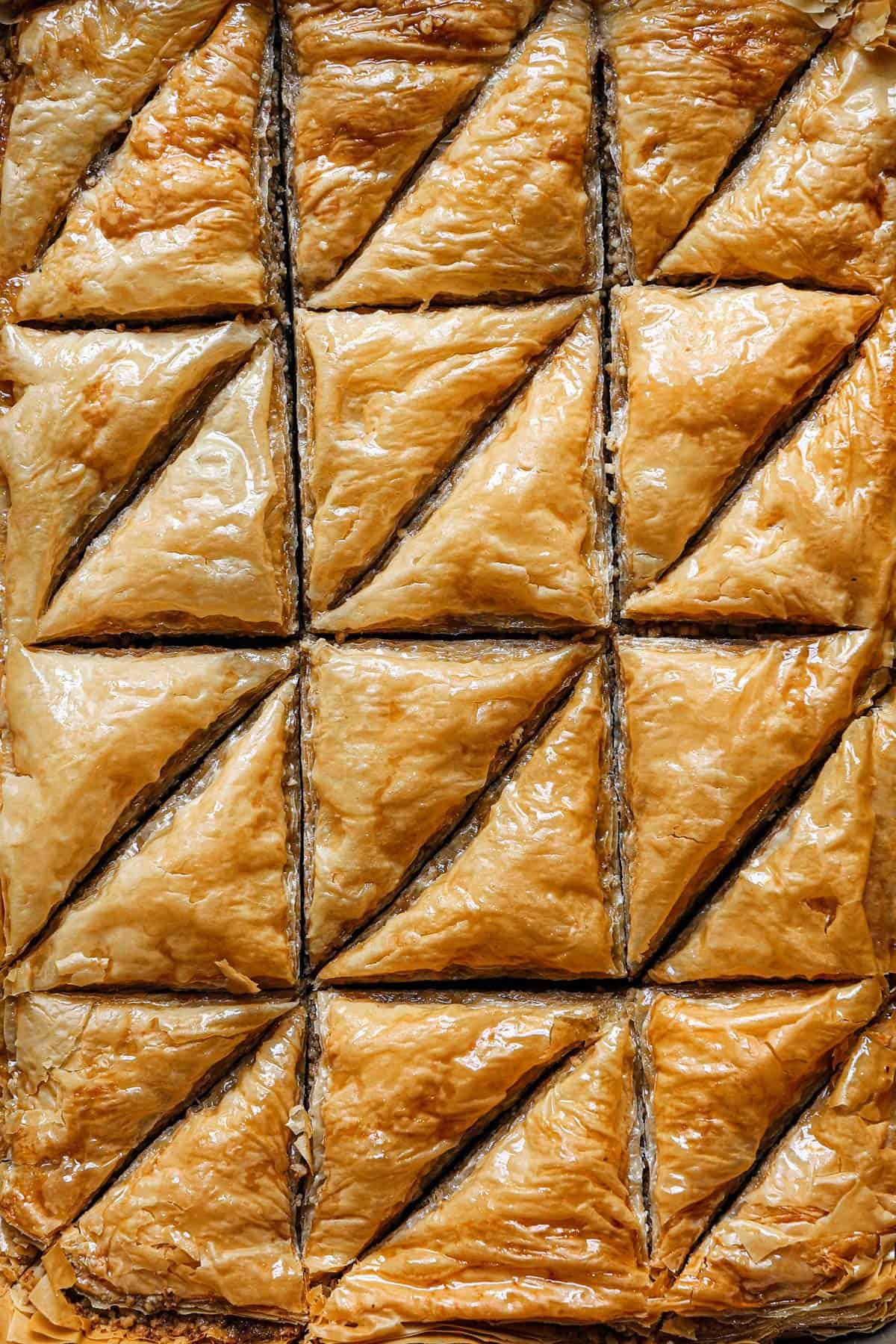
Storing, Freezing, and Making Ahead
One of the BEST things about baklava is that it’s an excellent make-ahead treat and it’s even better the second day, when the honey syrup has had ample time to soak into the nut layers.
- Storing: Keep baklava at room temperature in an airtight container for up to 2 weeks to maintain the flaky, crisp texture.
- Refrigerate: You can also store in the refrigerator for up to 2 weeks in an airtight container but it will be a little chewy and harder than at room temperature.
- Freezing: You can also wrap individual pieces of baklava in plastic wrap and store in freezer ziploc bags in the freezer for up to 3 months.
- Making ahead: This is an excellent dish to make ahead of time, as it’s actually better the longer it’s left to sit before it’s eaten. Covering it with a loose paper towel or a cheesecloth will ensure that it maintains its crispness.
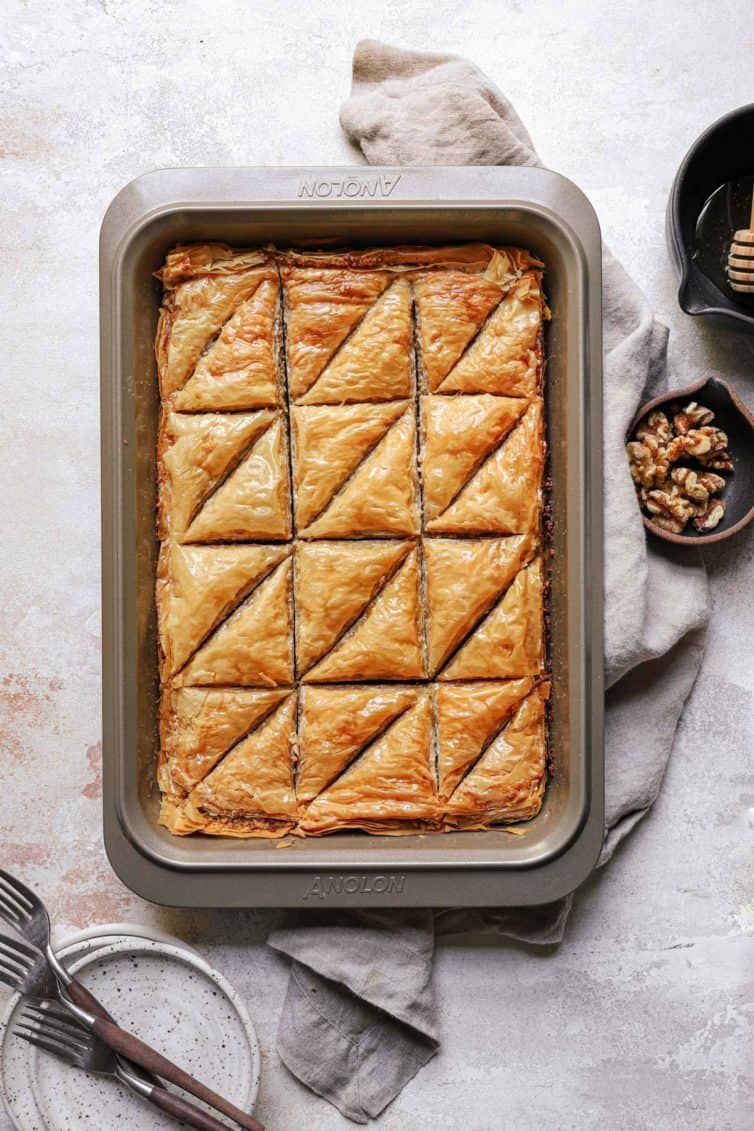
Serving Suggestions
Baklava makes a fantastic addition to any holiday sweets collection, wedding cookie table, or special celebration. Some of my favorite ways to serve baklava include:
- With additional ground walnuts on top.
- Topped with a little ice cream or homemade whipped cream.
- Served with a fresh cup of tea or warm cup of coffee.
Delicious Dessert Bars to Try Next:
- Fudge Ripple Monster Cookie Bars
- Blackberry Pie Bars
- Caramel Apple Magic Bars
- Symphony Bars
- Blueberry Crumb Bars
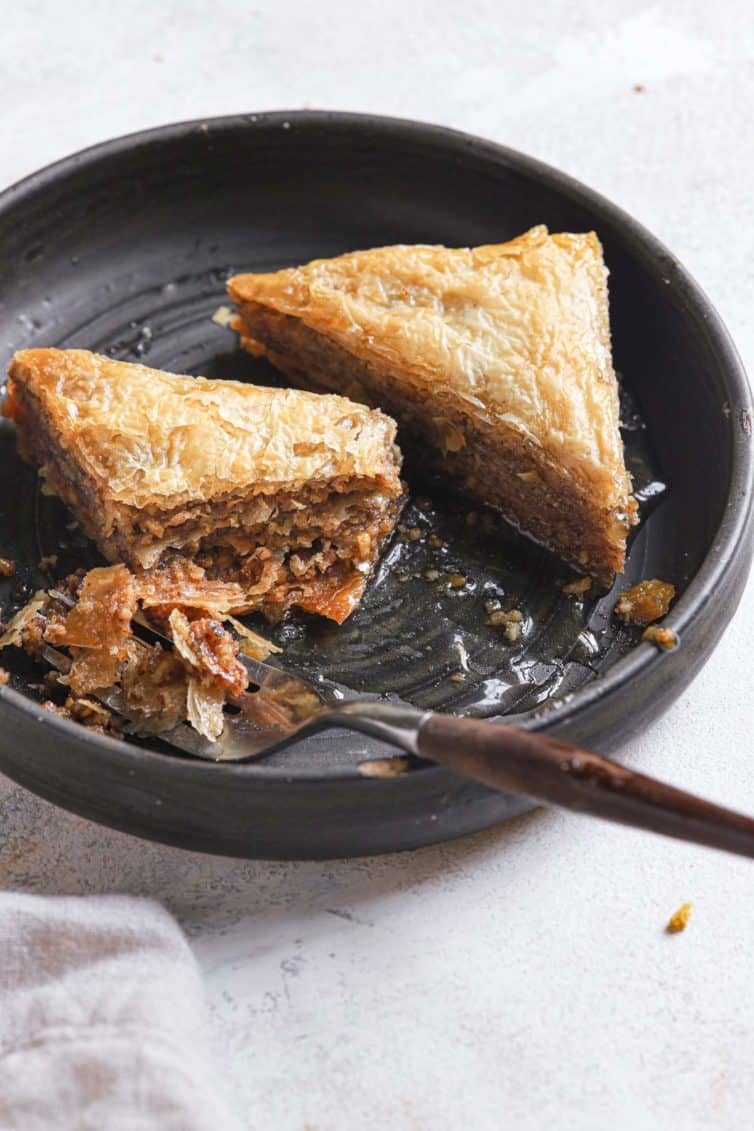
Crisp, flaky layers or buttery phyllo dough, spiced walnuts, and a sticky sweet honey syrup make this baklava recipe an unforgettable treat. This is a classic recipe that every home cook and baker needs to have stashed in their recipe box!
If you make this recipe and love it, remember to stop back and give it a 5-star rating – it helps others find the recipe! ❤️️
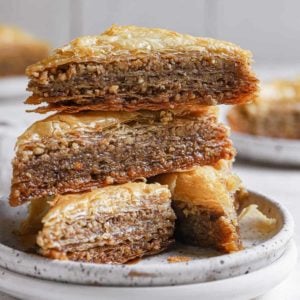
Classic Baklava Recipe
Ingredients
For the Syrup
- 1 cup (250 ml) water
- 1 cup (200 g) granulated sugar
- 1 cup (339 g) honey
- 1 cinnamon stick
- 1 strip orange peel
For the Pastry
- 1 pound (453.59 g) walnuts, toasted
- 1½ teaspoons (1.5 teaspoons) ground cinnamon
- ½ teaspoon (0.5 teaspoon) ground cloves
- 16 oz (453.59 g) package phyllo dough, thawed
- 1½ cups (340.5 g) unsalted butter
Instructions
- Make the Syrup: Combine the water, sugar, honey, cinnamon stick and orange peel in a small saucepan and bring to a boil over medium-high heat. Reduce the heat to low and simmer for 15 minutes. Remove from the heat and let cool to room temperature.
- Make the Baklava: Preheat oven to 350 degrees F.
- Place the walnuts, cinnamon and cloves in a food processor and process until the walnuts are finely ground.
- Melt the butter in a small saucepan over very low heat, keeping it warm throughout the process so it doesn’t start to solidify.
- Brush a 9×13-inch pan with melted butter and place one layer of phyllo at the bottom. Brush the phyllo with the melted butter, and then add another layer of phyllo, and brush with more butter. Continue this process until you have layered 7 sheets of phyllo.
- Gently spread one-quarter of the nut mixture evenly over the top of the phyllo. Repeat the process of layering phyllo sheets and brushing with melted butter, but this time use only 5 sheets of phyllo. Gently spread another one-quarter of the nut mixture over the top of the phyllo. Repeat this twice more, layering and buttering 5 sheets of phyllo and topping with one-quarter of the nut mixture. Finish off with 7 layers of buttered phyllo. Brush the top sheet with melted butter, as well.
- Using a sharp knife, trim any ragged pieces of phyllo dough that has crept up the sides of the pan. Cut the baklava into 12 even squares, and then cut into triangles (you should have 24 triangles). Place the pan in the oven and bake until golden brown, about 50 minutes.
- As soon as the baklava comes out of the oven, remove the cinnamon stick and orange peel from the syrup and slowly pour it over the hot baklava, making sure to get it into all of the cracks and crevices, as well as on the top surface. Allow the baklava to sit for at least 4 hours before serving so the syrup has a chance to soak in. (The baklava is actually best when left to sit overnight before serving.) Baklava can be stored at room temperature, covered very loosely with a paper towel or foil until ready to serve. Leftovers should be stored in airtight container at room temperature or in the refrigerator for up to 2 weeks.
Notes
- Storing: Keep baklava at room temperature in an airtight container for up to 2 weeks to maintain the flaky, crisp texture.
- Refrigerate: You can also store in the refrigerator for up to 2 weeks in an airtight container but it will be a little chewy and harder than at room temperature.
- Freezing: You can also wrap individual pieces of baklava in plastic wrap and store in freezer ziploc bags in the freezer for up to 3 months.
- Making ahead: This is an excellent dish to make ahead of time, as it’s actually better the longer it’s left to sit before it’s eaten. Covering it with a loose paper towel or a cheesecloth will ensure that it maintains its crispness.
- Nut variations: Other nuts, such as almonds or pistachios, can be substituted for the walnuts.
Did you make this recipe?
Leave a review below, then snap a picture and tag @thebrowneyedbaker on Instagram so I can see it!
Photography by Dee Frances


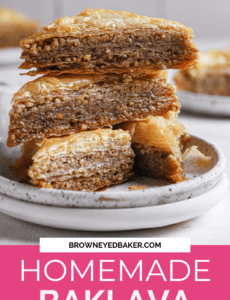



I will get back to you
This Baklava recipe is a true gem! The layers of phyllo dough and nuts perfectly blend with the spiced honey syrup. Can’t wait to impress my guests with this delightful treat!
I really want to make this but can you just clarify for me how to store it ? Do I leave it in the pan wwith a damp papertowel or cheesecloth over it? Am i reading that correctly? How long is it good for ? Also, how would you suggest gifting it? Would I put it in tins or boxes wirh lids ?
Thank you for all of your hard work.
excuse me, thank you for wanting to help me. Introduce me from executive
transportation services
travel rbj
I’m on a work holiday in your town now I’m around here just got to the top of my To Do List! Thanks for sharing the information and beautiful photos! Expensive! the info
https://www.qinayaprint.com/
It is a Turkish dessert and quite delicious. You can take a look to see the recipe :) https://gezilinki.com
Thats great article about Turkish desert, For more information about Turkey cusine and travel guides. You can visit us: http://gezipedia.com.tr/
Made with a walnut filling but https://banksnear-me.com/
topped with orange blossom water and uses much less syrup for soaking.
Hello Michelle, I don’t usually comment but these I made for Xmas because I have a friend that Baklava is their fave. they said these are the best they have ever had. I agree. but do you have a recipe for chocolate ones? I gave these 6 star out of 5. lol
Lost my original recipe that my sister brought from Greece. While I was visiting my sister her mother-in-law sent a 3 lb can of Baklava to her. Was I ever impressed. So glad to find the recipe again!
My kids love the taste of this cake so much they even promised me to quit playing their favorite stickman fighter game to ask me to make cakes according to your amazing recipe.
Nice post tiny fishing unblocked
I had only had baklava twice but loved it so much I decided to try to make it myself. This is the first one I found and I love it so much I haven’t tried any others. Why mess with perfection? Thank you so much for sharing this recipe! I have made it several times
The best and ONLY baklava recipe I use…. no-fail and easy to follow!
I was missing my local Greek food festival this year, so when I saw this recipe, I had to give it a try! I trimmed the phyllo down to my pan size so I only had a little bit to trim off at the end of layering. This was an amazing and comprehensive recipe for my first time making one of my favorite desserts! Thank you!
Homemade baklava is one of the joys of the holidays for me. We tend to make this dessert every year around Christmas, and it doesn’t feel like Christmas until it’s time to make it. I love making it throughout the year, but it’s extra special during the holidays.
Hi,
many thanks for this recipe.
In the last 5 years I have been to Turkey twice.
Baklava was an indispensable part of every dinner:) i fell in love with this dessert. Your baklava looks very delicious and i will try it in the next days.
Thank you.
Have never made baklava but I think your recipe may make me try it next time I have a special occasion to bake for.
Thank you for the research you did; it was interesting to read.
I love the passion that exists behind this dessert! Thank you to every culture making it because all cultures love eating it. :)
I followed the recipe exactly and was not disappointed! Absolutely delicious!
baklava is a turkish food. you should come to turkey and eat the baklava than you can understand :))
IT IS MIDLEASTERN(!!!) AND THE BEST ONE IS MADE BY LEBANESE AND NOT TURKS.
Gaziantep, Its also a albanian receipe, Our parents have been making it forever. The difference is we do not use honey, sugar water is what we do. and ours is probably the best I’ve ever eaten, But thats because its what I know.
Tried this recipe yesterday and it turned out perfect! Best recipe that I have found for this delectable dish.
Hi , your work is incredible. I was really curries about how do you do recipe history research, can you help me to find the oldest baklava recipe ever?
Baklava is definitely a Turkis Food. Also, you shouldn’t use store-bought pastry to make baklava.
You should try the below recipe.
https://turkishfoodchef.com/baklava-original-turkish-baklava-recipe/
Made this for the first time and it turned out great! Everyone loves it and I will be making it again! Thanks!
I tried making my first ever baklava and it was delicious! I did make some changes. I used only 1 cup of butter. I 1/2 cups seemed like a lot. And after soaking the baked baklava I was concerned about my top layer. So I made a bit more with just 1/2 cup water and 1/2 cup honey. I added that hot syrup to the cooled baklava. And we tried the baklava the next day after letting it soak overnight and it is great. My very top layer of phyllo still want to slide off. So next time I might tray spraying the top layer with water…to see if that keep it moist.
I made baklava but the top layers of filo didnt stick together and were easily coming off to expose the the underlying layer of nuts, why is that? I left it to soak in syrup overnight but the depth of the syrup only came halfway up the baklava, is that perhaps why? Maybe the whole things needs to be immersed as, to be honest, the bottom layers of pastry stuck together fine 🤷🏽♀️
Miss place my recipe for baklava so I used yours. it came out perfect. Was a huge hit at the Full Moon Ceremony .
This is fantastic! My first time making the dish I look forward to every year at our local Greek Orthodox Church’s Food Festival. This recipe is just perfect. I added a chopped pistachio topping as a little variation but it would have been fine without that.
OMG, it is so delicious. My family loved it.
No matter how much syrup I use on my baklava, the top of the baklava always stays dry and falls off while trying to eat it! What can I do to prevent this?
Hi Michele, I would try drizzling the syrup in batches, and making sure it absorbs in between, and not just sliding off that top layer. I hope that helps!
My baklava is not really crispy. I changed from a silicone basting brush to a boar bristle pastry brush and it used much less butter. So that’ll be the first improvement. Secondly, I think I used too much honey syrup….but I’m not sure how to determine the right amount. Third and lastly, my recipe calls for cool syrup poured over hot baklava. However, I’ve read that the opposite, hot syrup over cold baklava, improves its crispness. I’m clueless about this…..
Help!
What is the nutritional information on this please .
Regards
Matthew
Hi Matt, I’m working on getting that information included for all recipes. Keep checking back!
WOW! Wonder Baklava recipe. Looks delicious. Will try soon.
Can make the baklava, but do not cook until the next? And then follow the same steps with cooking and the syrup
Thanks
Hi Glori, I’ve never done this, I just don’t know how the phyllo would hold up to being brushed with butter and then sitting. You don’t want to put it in the fridge because the butter would solidify. Honestly, if you go through the trouble of assembling it, I would just bake it the same day, as it tastes even better after sitting overnight.
Thank you for sharing the recipe! I have never heard of Baklava, it’s so nice to know a new dish.
I can’t wait to try this recipe. I think there is a typo in the second bullet, third line under “How Do You Make Baklava?” I believe the word “would” should be “wouldn’t.”
Looks mouthwatering, will put on my , “to make list”. Thank you
I have made this recipe many, many times over the past few years. It always gets rave reviews. In fact many claim it is the best they have ever had. It isn’t difficult, but I always like a second hand – one to butter and one to layer. Thanks for posting it!
Oh this looks so good. I love baklava. One of these days I’m going to get over my fear of making it and try this recipe.
Do you cut the baklava through all layers or just the top seven? I will definitely be making this and your but roll recipe this year for Christmas. The but roll reminds me of our sweet neighbor who just died at 89 years. She made the best but rolls. Thank you for all your wonderful recipes and stories.
Hi Judy, I cut through all of the layers. And my deepest sympathies on the loss of your neighbor ❤️️
Baklava is such a great treat! Looks so delicious!
Be sure to come to “Atatürk Arboretum” in Istanbul. :)
Yes I went there, it’s a great place. (Atatürk Arboretum) Those who want to go: https://seyahatdergisi.com/ataturk-arboretumu-nerede-giris-ucreti-ziyaret-saatleri/
Baklava is eaten in gaziantep city :)
Just made this. While it tastes delicious, I would definitely make adjustments particularly to the quantity of butter. This is WAY TOO MUCH butter! It was so soggy, it didn’t have crispiness at all like baklava does. The taste was fine but because of so much butter, the crispiness was gone. I haven’t tried it again but when I do, I will definitely reduce the amount of butter and maybe butter every other sheet like other recipes call for. Also, make sure the syrup isn’t boiling hot. It should be poured onto hot baklava right out of the oven, but the syrup itself shouldn’t be right off the stove. Let it cool down just a bit. Thanks for the recipe but I’ll make adjustments next time
I made the Cooking Light version of this many years ago (a Cooking Light Baklava…I know, but hey, whatever lets you sleep at night, right?), and have had it from the local Lebanese market many times. It’s just a ridiculously deliciousness dessert. Thanks for sharing. I used walnuts as you did, super happy with the results:)
This is likely just my Middle Eastern tendencies shining through, but… NO ARAB WOULD EVER USE HONEY SYRUP! That’s a Greek ting! So, just as a note… if someone prepares this dessert for an Arab/Turk/Kurd, look up a recipe for Atyr syrup. It’s a beautifully floral sugar syrup… once you go atyr, you never go back. :)
baklava is a turkish food. you should come to turkey and eat the baklava than you can understand :))
ALSO!!! If your phyllo breaks on a dry day, don’t fret!! You can make a “Patch Quilt” out of the pieces. The melted butter will glue everything together seamlessly! Don’t be scared to try it!!!
I’ve been making Baklava for 22 years and this recipe is VERY close to mine so I KNOW it’s delicious!! OPA!!!
Hello everyone, baklava belongs to Turkey, not Greece.. it is characteristic of the cuisines of the former Ottoman Empire…
Turkey, Greece…. whatever. OPA!!!!
Ohhh this looks so so good. I never thought I could try it myself but this doesn’t look too hard :) Yummo!
I LOVE baklava. Always thought it would be really superdifficult, but when I saw your recipe on here I thought it seemed totally manageable! It’s quite possible that I lost count with the sheets, but I actually didn’t use an entire box of 16 oz of phyllo dough. No problem…I’m definitely making it in a couple of weeks for our Christmas celebration so the leftover phyllo dough will be used quickly! Thanks for yet another awesome recipe.
I made these for our Canadian Thanksgiving. They were easy to make, and came out beautiful. The only adaptation I made was I added a little vanilla extract to the syrup after it had cooled. I will be making these again.
Ooh! I made this a short time ago, and it was quite easy to make! Yours looks terrific!
Oh my goodness! I have to make this. My mouth is watering in anticipation of that salty/sweet/spicy flavour.
Yay! So glad you like this recipe. I really need to make it again soon but the only time we’re around enough people to finish it off, it’s my in laws and most of them don’t eat nuts. Boo.
Love Baklava! Can’t wait to try out this recipe.
Can I just say? You read my mind!!! Okay… Maybe, I yelled that out a bit loud. OMG! Thanks to you, I’ll be getting my Baklava fix this weekend.
The Baklava looks decadent. I’d like to make it soon. How many boxes of filo dough do I need for this recipe?
Hi Ela, Just one (16-ounce) package of phyllo.
the first time I had baklava was probably when I was a wee one. Maybe because of all the Turkish and Greek influences in my cuisine, but it was a dessert almost everyone would learn to make by the time they are 10.
The most common ones were with walnuts (English walnuts) and later when traveling to Turkey wasn’t considered a luxury with pistachios.
Looking at your baklava reminds me of Sunday afternoons when we’re gather and enjoy a piece of sweet sticky baklava.
I love baklava, but it’s so hard to find really good baklava. This certainly looks like it’s outstanding. I might have to find some time to give it a try.
This makes baklava sound so much more doable than I previously thought it was! I love the perfect triangles :)
Baklava is one of my husband’s favorite desserts (okay, I like it too) and he’s asked me on occasion to make it but I just haven’t found a recipe that spoke to me…until now.
Nice recipe. Sounds easy. I have never made baklava because I’ve always been warned how difficult it is to make. But this recipe doesn’t seem difficult at all!
I’ve always wanted to make baklava but I just never got around to it. I’ll have to try this recipe.
Baklave has always been a fearful place to go for me…..It won’t be this fall.
These look incredible and sinful all at the same time.
Scrumptious! Love baklava!
Yum!! I’m going to use pecans! :)
I just made this for the first time recently and was surprised how easy it was, with a little patience, to get that delicious, deep flavour! Your baklava is gorgeous!
Thanks so much for this recipe! i LOVE baklava and have wanted to make it for a while but was kind of scared to try:) thanks again…i can’t wait to try it!!!
Oh wow! It looks perfect!
Anyone can join the action, from children to adults, wordle today is a fun and easy-to-play game.
Looks amazing, as usual! For those who have been intimidated by phyllo, a key to working with it is to keep it from drying out. I lay it out flat and cover it with a damp towel on a sturdy piece of plastic wrap to keep that from happening. Cover it back up EVERY time you take a sheet off. It adds a little to the prep time but well worth it. Also, with baklava, the only sheets critical to the final appearance are the top couple, so don’t worry if some of your sheets tear while you’re working with the lower layers.
Hi Marla, Thanks for sharing these tips! I kept my phyllo covered with a damp paper towel while I worked, I forgot to mention that above!
Love the color of your baklava – just right!
Your baklava looks perfect. I wish I could reach through the screen and grab one!
I absolutely love Baklava!
I’ve never made baklava…I’ve always been to intimidated,but I have had some great baklava. In fact I think I almost chose a college based on baklava. Years ago at an open house my mom and I attended during lunch they served us some killer baklava and I turned and looked at my mom and said “if this is what they’re serving here I’m in!” It was the most wonderful thing either of us ever tasted…and thus a testament to my obsession with food.
Your photos are excellent, I’ve never made a baklava.
Baklava from Turkey
yes this is true baklava from Turkey
I LOVE baklava but have never made it at home…you make it look totally do-able, thank you!
Baklava is one of my great weaknesses, but I’ve never made it! Your recipe sounds very doable. Can’t wait to try it! Thanks.
I’ve always wanted to try making baklava, but the process seems so intimidating! It’s one of my favorite desserts, and your version looks delicious.
This is something I’ve always wanted to try!
That baklava looks really good!